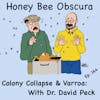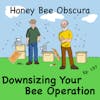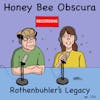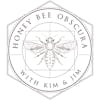Uncapping Honey (140)

After building your colonies up in the spring, managing them through the early summer, collecting them out of the trees and out of the bushes after they swarm and all the effort maintaining their health… your goal as a beekeeper is to harvest honey....
 After building your colonies up in the spring, managing them through the early summer, collecting them out of the trees and out of the bushes after they swarm and all the effort maintaining their health… your goal as a beekeeper is to harvest honey. You’ve lifted the supers of honey from the hives, get it to your garage, shed or even kitchen and you pull a frame of pure honey out… and now what?!! This is the meaning of all that time, effort and money.
After building your colonies up in the spring, managing them through the early summer, collecting them out of the trees and out of the bushes after they swarm and all the effort maintaining their health… your goal as a beekeeper is to harvest honey. You’ve lifted the supers of honey from the hives, get it to your garage, shed or even kitchen and you pull a frame of pure honey out… and now what?!! This is the meaning of all that time, effort and money.
So, how do you get the honey out from under that wax cappings?
In today’s episode Kim and Jim discuss the different means available to a backyard beekeeper to remove the cappings and get that frame set to extract.
How do you uncap? Let them know!
______________________
Thanks to Betterbee for sponsoring today's episode. Betterbee’s mission is to support every beekeeper with excellent customer  service, continued education and quality equipment. From their colorful and informative catalog to their support of beekeeper educational activities, including this podcast series, Betterbee truly is Beekeepers Serving Beekeepers. See for yourself at www.betterbee.com
service, continued education and quality equipment. From their colorful and informative catalog to their support of beekeeper educational activities, including this podcast series, Betterbee truly is Beekeepers Serving Beekeepers. See for yourself at www.betterbee.com
______________________
Honey Bee Obscura is brought to you by Growing Planet Media, LLC, the home of Beekeeping Today Podcast.
Music: Heart & Soul by Gyom, All We Know by Midway Music, original guitar music by Jeffrey Ott
Copyright © 2023 by Growing Planet Media, LLC

Episode 140 – Uncapping Honey
[music]
Kim: Jim, a while back, oh, I don't remember how long ago, it was a while back, we were talking about getting honey off your hives, just getting the box off the top of the stack and getting it back to wherever it is it's got to go, and then we talked about extracting it, but we missed something in the middle there.
Jim: Kim, I do remember that. It was not quite a year ago that we did several segments on discussing that. I remember it.
Kim: Well, I think the thing that we missed the most was the, I'm going to say, fundamental art and fundamental task of getting the cappings off the top of the cells so you can get the honey out of them.
Jim: Yes, we discussed extracting and different kinds of extractors and heat and then getting the honey off, the headache of getting the bees to let it go, but you're right, we didn't discuss uncapping.
Kim: Well, hi, I'm Kim Flottum.
Jim: I'm Jim Tew.
Kim: Today, I think we're going to take a step back and look at all of the, or at least many of the things that come up when you start talking about uncapping, tools and timing and all of that. I think we're ready.
Introduction: You are listening to Honeybee Obscura, brought to you by Growing Planet Media, the folks behind Beekeeping Today Podcast. Each week on Honeybee Obscura, hosts Kim Flottum and Jim Tew explore the complexities, the beauty, the fun, and the challenges of managing honeybees in today's world. Get ready for an engaging discussion to delight and inform all beekeepers. If you're a long-timer or just starting out, sit back and enjoy the next several minutes as Kim and Jim explore all things honeybees.
Jim: Kim, this is one of those tasks that's not beekeeping at all. Nothing about uncapping is beekeeping. Nothing about honey extracting is beekeeping, but it's just one of those things that you've got to get it done. What do you use, how do you uncap, all those kind of things. There's never a perfect tool. There's all these different techniques. Now, we have some techniques that we have ahead in the past. It's still an evolving issue on how to get those nice white cappings off that honey crop so we can sling that honey up.
Kim: Here's another part of being a beekeeper. What's your time worth? If you've got lots of frames and not a lot of time to get them harvested and back on your bees, you can look in one way. If you've got three weeks to do this before you have those boxes back on the hives, there's a whole lot of other ways. I tend to be somewhere in the middle of that. I don't have hundreds of hives. I don't have 10 hives. I'm in the two, three, or four most years. When I look at how many hives I've got, how many frames I'm going to have to uncap, and the equipment that I have to do that, and knowing a little bit about how each of them works, the amount of work that it takes, the amount of cleanup time, that's a big part of this.
Jim: I was waiting for you to take a breath so I can say. While you're waiting three weeks to get this small job done, the wax moths and the flies and the other animals don't wait. They're there to help you.
Kim: Well, if you've got a 10-frame box, it doesn't make much difference. You only got one, you got 10 frames, and you're going to get that uncapped. You're going to collect the honey. You're going to separate the wax from the honey and get the honey bottle and get it out of your garage before, what, thanksgiving? Because I'm small, there's a lot of pieces of equipment that are available that I could use. I don't use them because they're messy. This is the messiest part of beekeeping without a doubt.
Jim: Isn't that the truth? This is a messy part of beekeeping. Try as you might, this uncapping phase is just going to be, it's almost like painting. You might as well go ahead and just get the paint all over you and spell some and just get it over with and that way, it's done. This uncapping process is a little bit the same. It's just really easy to get honey on everything in the surrounding area.
Kim: Well, a real basic tool is an uncapping scratcher. It looks like kind of an upside-down fork. It's got 10 or 12 prongs on it that are really sharp and it's slanted up so you can put the uncapping scratcher on the edge of your frame and the parts of the fork will be below the surface of the cappings on that frame. Well, that's what it's supposed to be. Then you just slide that all the way across to the other end of the frame, and you take a look, and one-third of the frame is uncapped. You've got a whole bunch of honey and wax on the uncapping scratcher and you clean that off into a pre-designed bucket, and you do it two more times and you're done.
Jim: That thing should be called the cappings mutilator instead of a capping scratcher. You were talking like a very controlled way of doing it, but I want to tell you, Kim, when you've got that frame in front of you and you've already maybe used some other techniques and the capping scratcher is trying to get up under the top bar and the end bar, you just screw things up. Just gouge those cappings open enough that that little bit of honey can sling out. I use it both ways. I use it the way you said, just lightly catch underneath and pull the cappings off, but if I'm in a hurry or if that technique is clumsy, flip that thing over backwards and just in some way puncture those cappings enough for the honey to sling through.
Kim: That works well for those places that are hard to reach. The biggest problem with this is the biggest problem with beekeeping. They don't read the books. When they're putting their cappings on their honey, they put it on the way they want, not necessarily the way I want. There are some races of bees, some genetic lineup that once the honey is in the cell and they cap it, the cappings are concave. They're sloping down instead of standing up and uncapping fork for those things is worthless.
Jim: That's one of the reasons, Kim, that some of the accomplished beekeepers tell you to run nine frames, to take one frame out and then let those frames be a little bit farther apart to encourage the bees to build those cappings out from under the top bar and away from the end bars, so you can get some kind of uncapping device, in this case, the scratcher, to be able to get to those cells. You're right, if there's a comb aberration and drones are put there or something, the opposing frame that it's facing will be indented and it's really hard to get a knife or some other automatic uncapping device to dip into that hole. That capping scratcher is just the simplest thing in the world, but it's an invaluable tool at that point.
In a horrible scenario, just take a hive tool and use it to crush the cells open. All we're doing is just pushing those cells open. One thing you haven't mentioned is that you have to pay a due later on because you got all those cappings then that'll be in the honey and that's going to either require you to change your filter a lot or to let that honey settle to get those cappings off the top of the honey after they sit there for a couple of days, four days or so, to let those cappings rise to the top and you can skim them off then. It may be quick and expeditious and simple on one hand, but there's a bit of a price to pay later on.
Kim: Have you ever used a honey punch?
Jim: I have. That's kind of a variation on a theme, isn't it? It's like a capping scratcher on a wheel, on a drum. Once again, what are you doing, Kim? You're mutilating cappings.
Kim: Yes.
Jim: It does work. It's surprising, Kim, that you think-- Well, let's just put it in the extractor, run it real fast, and sling it out. On one hand, those fragile cappings seem so delicate and so light, but on the other hand, we have a hard time slinging that honey through those cappings if they haven't been pierced or weakened in some way.
Kim: Another really common way that people look at accomplishing this task is to use an uncapping knife. There's pluses and minuses with that just like there is with the scratcher. The good thing about an uncapping knife is that if you've put in nine frames, I got to write that down and remember that next year, if you put in nine frames and all of your cappings are above the edge of that frame, an uncapping knife will go through there like a hot knife through butter.
Jim: It's just heavenly.
Kim: Yes, it works well. That saves a lot of time and it doesn't damage the cells very much until you get that frame that's about two-thirds not full. The cells are full of honey. They're capped, but they're below the edge of the frame that you're trying to-- How do you handle that?
Jim: Well, then I'm going to go right back to the capping scratcher or to the punch or something to help with that, because your impulse is going to be to turn that knife up on its end and try to open those cappings up. You can do some of that, but it's clumsy. Let me tell you, Kim, while I'm trying to do that, while I'm moving that knife around and holding it at odd angles, number one, it is hot as blazes. It will burn you, so you can't accidentally touch it. It's sharp enough not to just slash you, but it's sharp enough to cut you. You're using a knife that's a fairly big knife, and it's hot, and it's in a clumsy position, so it's easy to make a mistake, but not the least of which is to dribble scalding honey on you, kind of like hot tar.
Yes, I use a hot knife. I was thinking while you were talking that, in the extracting world, a hot knife should almost be like a hive tool. You've just got to have one. You and I both, through the years, and everybody listening, this is just a tool we just love to hate. After a while, the handle is sticky. It's dripping honey everywhere. It just does its fair share in making a mess everywhere.
Kim: There's a couple of things to think about on that. You don't have to have a heated knife. You can have a knife without a heater that you're keeping in a tub of warm water and that works. You think about getting water in your honey, but so little water comes off with so much honey coming off the frame that you can make it work, but then you've got to have two because one's heating while you're using one, and then you switch for the next frame. We've mentioned the capping scratcher and the punch, and electric knives, both heated and not.
Jim: Before you get away, you were talking about those unheated knives. I know that if you're a hobby beekeeper and you've got five or six frames first time, just get out that kitchen serrated knife, and best you can, open those cappings up. I mean it'll do it. It's not going to be the most fun job you've ever done. On those heated knives, I think that that technique was the way this all started, was having two, three, or four knives, and keeping them all in really hot water, and then always using a knife straight from that hot water to keep softening those combs.
I remember seeing the old, old catalogs that had steam connectors on those knives so then you'd have a simple steam generator coming off a teapot or something and with a flexible line, and you'd run steam through that knife, keep it hot that way. When someone put an electric element in that knife, I think that that was the way to not turn back. At this point, why don't we just take a break, and hear from our bee supplier company here that has these very knives available to you.
Betterbee: It's summertime, and the varroa population in your hives is booming. Target varroa now with ApiLife Var to protect your hives from mite-borne diseases down the road. With over 30 years of international use, ApiLife Var is a natural thymol-based treatment with an effectiveness that exceeds 94%. Learn more and get yours from Betterbee today by visiting betterbee.com/alv.
Kim: Well, one way around some of that anyway is to have an electric knife that has a thermostat on it. You can set it at whatever temperature you want and the temperature's going to be not hot enough, barely hot, almost right and too hot. That's the way I've always found them to go. It gives you a little bit more control in what your knife can do and can't do, and what you can and can't do with it, and how much time it might save you if you were able to use it well.
Jim: Have you ever used a cappings plane, an uncapping plane?
Kim: Yes, I have, once. They work well. They're a lot like a scratcher in a lot of ways, in that there's uncapped cells that are below the level of the rest of the frame. It's going to miss most of those. Otherwise, it'll just take off what the scratcher did. The problem I have with it is arthritis in my hands. Running that thing for a couple of hours, I'm going to have to sit down for a couple of days to see if I get my thumb back.
Jim: Oh, I understand that. That's an argument that I have with almost any of these devices, especially that uncapping knife. I'm back to the uncapping knife now. I'm sorry to go backwards. If you're uncapping older combs that are fairly thick and older, dark cappings, you have to really saw through it with that knife and after just a few hours of that, my wrist and hand is aching. You try to use it left-handed, or in my case, opposite hand, and then that's just a good way to make a mistake and have a knife go flying. A capping plane, how would it work on older cappings, darker cappings, thicker cappings? It's electric. First of all, it is electric, isn't it?
Kim: Three point.
Jim: I thought they were heated.
Kim: Yes, they're heated. There may be some out there that aren't heated, but the one I used was heated. You had some kind of control over the heat settings. The first point on that is cost. Time is money. If it saves you a lot of time, but it costs you a lot of money, are you ahead of the game? Or if it takes hardly any time at all and it costs you a fortune or any combination of those, so when you're looking at a piece of equipment, time is money. How much is this worth, how much of my time is this going to save, that's one big point. The other point with that, in my opinion, is that I had less control with the blade that you're taking across the surface of the comb. That was probably a learning curve and I didn't learn it in the time allotted, so I didn't do a real good job, those three things to me. It's going to be different with you and different for everybody listening to this. I got big, strong muscle hands, no problem, those sort of things.
Jim: Well, it ends up just being like you've said in the past, what speeds things up, what makes this unpleasant job move along as quickly as possible. When you read it in a magazine or when you refer to it in a book, it just seems so straightforward. Take a knife, cut the cappings off, put it in the extractor, sling the honey out. Oh man, in this case, the devil is in the details. You're stringing honey from the uncapping tank to the extractor when you've cut the cappings off and the knife's lying there hot and melting wax behind it. This handle is sticky and my hand is hurting and I just wish there was somebody else who'd come do this for me. There's all of that. I'm just complaining now. What results come in the final end is a nice, delectable honey crop, but it's not easy to get to that.
I'm off the subject, I've always really appreciated it when some beekeeper hands me a nice, clear bottle of honey and says, "I want you to try my honey." That's like giving me a pint of blood. There was a lot of work to get that honey in that jar and get it all nice and clean that way. Kim, there's an old, old model uncapper. I don't know if the thing's still made or not, but it was on two offset cams. It was basically a hot knife mounted to an electric motor with a pulley and a belt on two offset cams and when you plug that motor in, the knife would vibrate back and forth on those offset cams. If you've ever seen such a contraption, it was available for years. I don't know if anything like it is still made. You would lay the comb across this vibrating knife, and instead of you having to use your wrist, that motor did the work for you.
Kim: I've never seen one of those. I've never heard of that. I can't imagine the number of things that can go wrong with that.
Jim: Well, you can imagine the big ones, can't you?
[laughter]
Jim: How many stitches is it going to take to get that thumb back on that you let go by that vibrating knife? Kim, can it get worse? Oh, yes, it can get worse because the knife was heated with steam. Not only was it vibrating there, but it was also a hot knife. It did make life a lot easier. I've got a picture of one somewhere. I'll try to include it for Jeff to use maybe in the show notes here or somewhere to show this thing we're talking about. I'm suspecting that it's probably in the legacy equipment category now, something that used to be but is no more. I'm thinking that as you and I have talked, we have not come up with the end-all method for a small to mid-size beekeeper to get the cappings off. Anything beyond these handheld tools, you're going to cross right over into much bigger equipment with bigger dollar figures on them.
Kim: That's when time is money comes in, without a doubt. You really have to look at that. No matter how much you're spending, think of three years down the road, where are you going to be? Well, I moved to California, so that's out of the question. What's going to be the trip for this in three years? Is it going to be way too small, still big enough, or not quite big enough anymore, whatever? You spend $30, $50, and after three years, you write it off, and maybe you sell it to a new beekeeper in your club for half price, and he gets a deal. You got rid of a piece of equipment and you can move on from there, but know what you're going to be three years from now before you spend that money.
Jim: I would like to add this. One of the good points is, as we close out, a capping scratcher and a hot knife, you just can't go wrong. I don't care if you've got a really first-class mechanical uncapper there. Even when we were running those, we always had a hot knife somewhere close by and a capping scratcher close by. Even if you plan on growing, you're probably still going to have that thing plugged in when you're uncapping.
Kim: Primarily, I use a scratcher to get those corners and bumps up by the top bar. My bees are, well, they didn't go to uncapping school [chuckles]. I was looking at them yesterday. This year, I got smart. I put six frames in an eight-frame hive and it's going to work really well. When I get it, of course, I'm going to have less honey.
Jim: Wow, you're almost making-- That's Kim Flottum comb honey when you uncap that thing. Well, it sounds like we're in agreement, though. You're okay having a capping scratcher and a hot knife as just fundamental tools pretty much for any beekeeper short of a full-blown, flat-out, commercial honey producer. Right or wrong?
Kim: I think that's right, with one tiny exception, I want to make comb honey.
Jim: Oh, that's not a tiny exception. That's a huge ground-changing concept.
Kim: Let's take it another step. Cut comb honey. We'll have to look at that sometime. That's a dance with the devil.
Jim: I don't know if you could use that. I'm not going to do it. I'll get off the subject. Well, we'll save that. I was just about to get off the subject but, hey, our time is up. I got to stop it.
Kim: Okay, yes, me too. I got to go look at bees is what I got to do today.
Jim: All right.
Kim: Well, catch you next time, right?
Jim: I'll be right here thinking about bees. Hey, thanks for listening, everybody, and goodbye to you, Kim.
Kim: Take it easy, guy.
[00:21:33] [END OF AUDIO]
New to Honey Bee Obscura Podcast?
Here are some great episodes to start with. Or, check out episodes by topic.













